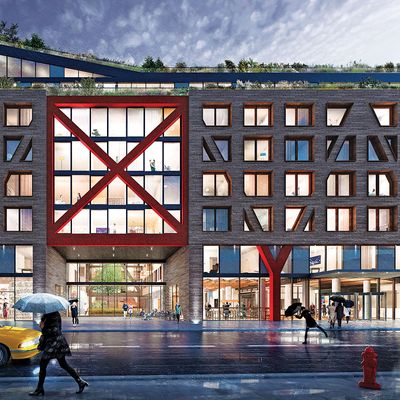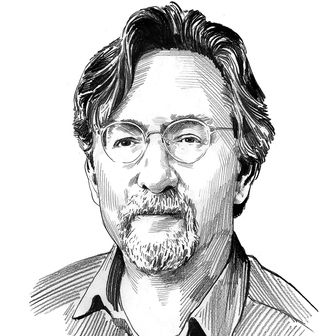
Can an architect design a kinder, gentler gentrification? That question hums like a drone through a vast empty lot in Bushwick where the Rheingold Brewery once stood. Eran Chen, the Israeli-born founder of the architecture firm ODA, has sugarplum visions for this desolate stretch: nearly 1,000 apartments and a million square feet that would slip affably into a neighborhood that, despite its real-estate hotness and brand-name cool, remains tenaciously poor. Longtime residents and their new neighbors would mingle in the woodworking shop and photo lab and hang their creations side by side in the community art gallery. A microbrewery would open up onsite, making reference to the past while providing local jobs and drinks.
To accommodate this genial fantasy — and to satisfy his client, All Year Management — Chen has designed the future 123 Melrose Street as a pair of E-shaped buildings that reach out to each other across a linked set of parklets filled with ferns and cherries and café tables. The idea is to use the two-block site to break down the Brooklyn grid and make it seem less implacably rational. Instead of enclosing a single courtyard or wrapping a park around a set of towers, ODA interlaces private structure with public space. A long eight-story perimeter rises to nine at one corner, like a stumpy watchtower. Balconies and hallways look out over inner courts. Stores face both out to the street and in to the compound. Sky bridges connect rooftops, where residents can grow their own produce on their upstairs farm.
To the passerby, the Rheingold site looks like that urban rarity, a clean slate, but in fact every long-fallow acre in the city is a battleground, especially in a neighborhood where crime, rents, and construction are all disconcertingly high. In 2013, the site’s then-owner, Read Property Group, seemed to understand that, even if not a single stoop gets demolished and not a single resident displaced, an affluent influx will rattle longtime residents. In exchange for the city’s converting the site from industrial to residential use, Read offered written assurances that the company would make 30 percent of the apartments affordable and kick in more than $1 million for local parks, tenant protection, social services, and computer labs. Diana Reyna, the councilmember at the time, supported the rezoning, and the City Council passed it. A few months later, Read sold off the property in chunks, and its promises turned out not to be binding on the buyers, including All Year. The community had to start negotiations all over again with new owners and virtually no leverage left.
Still, it’s worked out pretty well so far. Before walking away, Read donated a parcel of land to a nonprofit affordable-housing developer. More recently, All Year’s head, Yoel Goldman, has said he would make 20 percent of the new complex affordable. (Unfortunately, “affordable” is a vague term that can actually mean very expensive by the standards of Bushwick’s low-income residents.) In Chen’s telling, the project provides the community activists with everything they have asked for and more: inexpensive apartments, open space, and an invitation to use (at least some of) the new goodies.
Chen hopes that arrangement of alleys, arches, and enclosures will recall what marketing materials describe as a “European village,” a disastrously tone-deaf phrase. “To say that you’re going to put a European village in the middle of an impoverished community that’s mostly black and Latino, what are you implying?” asks Stephanie Cancel, an organizer at the advocacy group Churches United for Fair Housing. “We know exactly what’s happening: It’s gentrification.” That it is, and in truth the architect and developer might have invoked other models, though none likely to placate suspicious longtime Bushwickers.
Apartments, yards, stores, cafés, and art spaces, fused in a former industrial zone — various combinations of these ingredients are hardly new. Sunnyside Gardens, Stuyvesant Town, and Tudor City mixed middle-class housing and public greenery lifetimes ago. The Kulturbrauerei in Berlin transformed an abandoned brewery, all work yards and outbuildings, into a sprawling arts complex. In other parts of the country, a vaguely European, landscaped enclave where people live, shop, and eat out — CityPlace in West Palm Beach, for instance — falls under the Orwellian rubric lifestyle center. The scheme also evokes an urban college campus (like the similarly sized two-block rectangle around Columbia University’s Low Library) more than it does Zermatt. That’s not accidental, but it’s precisely why Chen believes that the project’s communitarian spirit makes financial sense.
“The developer wants to rent close to 1,000 apartments at the highest rent he can get, many of them based on shares,” says Chen. “People get smaller spaces of their own, but a lot of community space, which keeps the rent down per person but high per square foot. That would be super-attractive” — especially to recent college graduates who enjoy the upgrade on dorm life. That hardheaded business calculus jibes with the community’s desire not to be excluded. “If you open your building up to the city and create opportunities by which the communities around and within it are invited, and you design a program to encourage gathering and positive activity, you’ve added something that doesn’t exist.”
ODA has only been around since 2007, but already it’s peppered the city with buildings, ranging from leviathanlike to inconspicuous. One of its most visible projects, the Pier 6 towers in Brooklyn Bridge Park, hasn’t even begun construction yet — and never will if the Brooklyn Heights Association wins its suit to scrap the project. ODA has also designed three bulky towers on the Williamsburg waterfront, developed by Eliot Spitzer. The firm has a method rather than a style. Most architects interpret zoning regulations as an assembly manual, producing buildings that look almost exactly like the schematic diagrams provided by the city-planning department. Others try to convince city government that their designs deserve an exception to the rules. ODA takes a jujitsu approach to those constraints. Rather than accept the prescribed envelope, they slice it up, punch holes in it, shuffle pieces like Lego blocks, all in order to create more articulated, lively, and congenial buildings that are simultaneously contextual and assertive. ODA is good at eking every last scrap of square footage out of a lot, without cramming it all into a big dumb crate.
Chen insists that Goldman has embraced the architect’s social vision as well as his design, but he recognizes that his role ends when the building opens, while its success will be measured by what happens long after he’s moved on. If the gates wind up staying closed, if the cafés are too precious and the shops too generically fancy, then all the best architectural intentions in the world can’t halt the creation of a pseudo-urban dystopia, a barricaded enclave with the look of a city and a suburb’s soul.
*This article appears in the August 8, 2016 issue of New York Magazine.






























